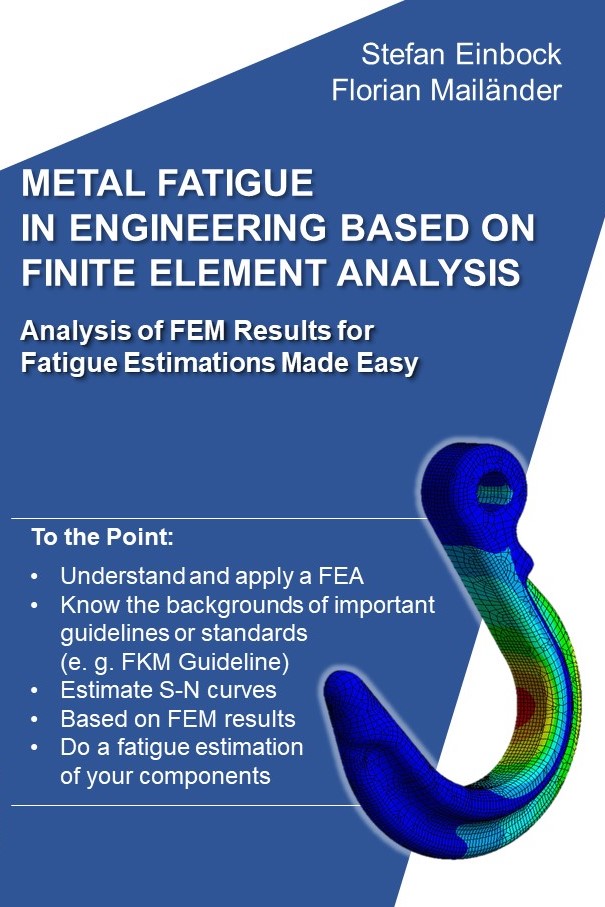
Metal Fatigue in Engineering Based on Finite Element Analysis (FEA)
Analysis of FEM Results for Fatigue Estimations Made Easy
This book delivers an efficient entry into metal fatigue analysis in engineering of metal components. It especially focusses on the evaluation of finite element analysis (FEA). Therefore you will learn how to interpret a FEA, how to define a state-of the art finite element mesh and you will understand the backgrounds of modern guidelines like the FKM guideline.
To ensure quick and easy training, this book focuses on the most important methods and limits itself to only the necessary mathematics.
Metal Fatigue in Engineering Based on Finite Element Analysis (FEA): Made Easy
Frequently, a calculation of the fatigue strength is based on notch stresses. These can be calculated analytically (i.e., manually) from the nominal stresses and the stress concentration factor.
As an alternative to the analytical calculation of the notch stresses the FEA is an adequate method to simulate notch stresses. Familiarization with the fields of fatigue and simulation methods like FEA are difficult, especially if it is done alongside the day-to-day business. This book gives answers to the most important questions like:
- Why is the FEA mesh important?
- What element types do I use?
- Is the mesh quality sufficient for the evaluation of stresses or stress gradients?
- Which material data are required?
- Where to pay attention to during load assumption and evaluation of FEA results?
- How to calculate a component S-N curve for an FEA?
The two authors and trainers for metal fatigue methods in engineering and FEA Dr.-Ing. Stefan Einbock and Florian Mailänder summarize the basics of metal fatigue in engineering in an understandable manner. In addition, they deliver all necessary methods to do a fatigue analysis bases on finite element results on your own!
To ensure quick training, this book focuses on the most important methods and limits itself to only the necessary mathematics. In addition, you will find useful tips and experience in yourself, a significant increase in learning efficiency. Free practical Excel tools and material data allow you to apply the knowledge directly in your everyday professional life.
Many illustrations accompany the text. This gives you an understandable placement of the content. A simple and clear language is consciously used (the professional life is complicated enough). Extensive practical exercises are helping to strengthen the understanding of the theory. Each chapter closes with a short summary.
This book is just what you need, when you …
want to understand the basics of metal fatigue
This book focuses on the most important methods, it gives practical tips to increase your learning efficiency and explains the basics in a clear and simple language. Also many examples, illustrations and excel tools are given.
are looking for a quick introduction of FEA
You learn the basics of FEA, understand how to evaluate FEA results correctly by choosing the right mesh quality, using the right element types and evaluate the correct stresses. All topics are discussed on a real component.
want to interpret FEA results
For all topics useful examples and excercies are given. A real world component (crane hook) is used to train the methods of FEA and metal fatigue analysis.
The content
This chapter answers the following questions:
- Why is the FEA mesh important?
- What element types do I use?
- Is mesh quality sufficient for stresses and stress gradients?
- Which material data are required?
- Where to pay attention to during load assumption and evaluation of FEA results?
The FEM will be applied at a practical example. Download the geometry .stp File for free.
Fatigue is concerned with the design of components, structures, systems, and equipment for safe operation under time-varying operating loads for a defined life and probability of failure. Material failure can thereby occur either through static loads (static failure) or through fatigue loads (fatigue failure).
You will learn for concepts for fatigue estimations, the assessment
- of static strength
- with local elastic-plastic strains is done by the strain life concept (synonyms: notch strain concept / local concept / Low Cycle Fatigue (LCF))
- with local elastic stresses is done by the stress life concept (synonyms: notch stress concept / High Cycle Fatigue (HCF))
- of the infinite lifetime.
Besides the fundamentals of statistics are explained. These are the
- Important terms
- probability net
- normal distribution and the
- log-normal distribution.
Determination of the stresses in the component
- linear-elastic material behavior
- mulitaxial stresses
- elastic-plastic material behavior
- elastic-plastic calculations with FEM
Calculation of strength (plastic support factor/section factor).
Learn why plastic strains can be useful for a higher utilization of your component and learn the influence of
- Material
- Temperature
- Creeping
- Notches by plastic support factor/section factor
on the component strength.
Calculation of safety (allowable stresses)
- Typical safety factors
- Influence of the risk of failure.
This chapter gives an overview of the
- most important concepts of fatigue strength (stress concept (acc. To FKM Guideline), strain concept), the procedure of strength analysis, and the
- fundamentals of material behavior with time-varying loads.
- Stress components and equivalent stresses in FEM
- Calculation of elastic stresses (HCF),
- elastic-plastic stresses & strains (LCF) with FEM and Neuber’s Rule
- Rainflow counting
- Estimation and extrapolation of load spectrums.
The strength is specified by a suitable S-N curve depending on the choice of the concept. For a numerical metal fatigue estimation mathematically estimated S-N curves (HCF-concept) or strain-life curves (LCF-concept) are used. For their accurate estimation, all influences must be taken into account. These influences are:
- Material
- Mean stress (Goodman, mean stress sensitivity, Smith-Watson-Topper PSWT)
- Notches (related stress gradient, Kt-Kf ratio)
- Residual stresses
- Component size
- Surface roughness
- Temperature
- Frequency
- Corrosion
The calculation of component safety is done in two steps:
- the damage accumulation hypothesis compares the stress with the strength.
- and the safety factor represents the probability of failure.
The book contains the following topics:
- Damage accumulation hypothesis
- Modifications of Miner’s rule
- Haibach version of Miner’s Rule
- Elementary version of Miner’s Rule
- Consistent version of Miner’s Rule
- Relative version of Miner’s Rule
- Lifetime curves
- Safety factor regarding failure probability and the sampling risk.
Depending on the design tasks, it depends on the design principle used to design the component. Designs of safety-relevant components in mass production without inspection possibilities are designed according to different principles than, for example, an in-house test bench.
Read details about the following principles:
- Fatigue Safe Design
- Fail-Safe Design
- Damage-TolerantDesign and
- Strengthening Measures.
An extract of standards and guidelines that predominantly require a fatigue assessment is given. A distinction is made between industry-specific and general standards / guidelines.
To strengthen the understanding of the theory, the book is supplemented by extensive practical exercises and detailed step-by-step solutions. Each chapter closes with a short summary.
You can train the FEA topics with the FEA Example of the crane hook.
Each chapter closes with a summary of the most important formulae.
For easy application of the methods, you will find useful Excel tools. You can download these tools here:

Metal Fatigue in Engineering Based on Finite Element Analysis (FEA): Made Easy
This book delivers:
- an efficient entry into fatigue,
- understanding of modern guidelines like FKM guidelines,
- material and calculation data for fatigue assessment,
- the possibility to increase the utilization of components by carrying out a state-of-the-art strength assessment,
- the economic determination of safety factors,
- practice-oriented exercises to deepen learning,
- directly use the taught metal fatigue methods by using practical free Excel tools.
The authors
Dr.-Ing. Stefan Einbock

studied mechanical engineering at the Esslingen University of Applied Sciences and completed his doctoral degree in the area of fatigue at the Technical University Dresden.
He currently shares his theoretical knowledge on fatigue and reliability as a successful seminar leader for the seminars “Fatigue Calculations”, “Robust Designing and Efficient Testing of Components” and “Understanding and Implementing DRBFM”. At Robert Bosch GmbH, he heads the Competency Center for Fatigue of Metals in the Powertrain Systems division.
In order to make the knowledge of fatigue easily available to engineers, he founded the EinbockAKADEMIE (www.einbock-akademie.de). There, blog posts discuss current topics, books on fatigue are presented, and seminars and consultations are offered.
Dipl.-Ing. (FH) Florian Mailänder

After his graduation as an industrial mechanic, he studied mechanical engineering at the University of Applied Sciences in Esslingen in the field of Development.
Since 2006, he works as a simulation engineer and simulation consultant at CADFEM GmbH. CADFEM GmbH is a pioneer in the application of numerical simulation methods for product development and is an ANSYS Elite Channel Partner.
In his daily work, he is responsible for trainings and support. Content of these trainings include the software products of ANSYS Inc. and additional software like FKM tools inside ANSYS.
His focus is the structural mechanical Finite Element Analysis. Besides the training, he gained huge experiences in customer projects in the evaluation of simulation results. The principle of his work and CADFEM GmbH is: “Simulation is more than software!”
Error list
Have you found a mistake that has managed to creep in, despite the greatest possible care? Or would you like to give feedback? In that case too, I am happy to receive a short email.
In this case, please write me a short email at kontakt@einbock-akademie.de and as a little thank you, you will receive two chapters in addition to this book:
- Very High Cycle Fatigue. Or: Is there any fatigue limit at all?
- Optimal notch factor. Or: How do I find the best notch?
Here you will find an error list with all actual errors:
Download error list for the metal fatigue book
Thanks a lot for your support and your feedback!
Best regards
Stefan Einbock
